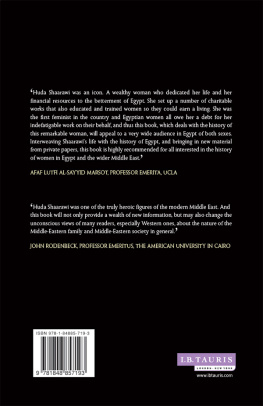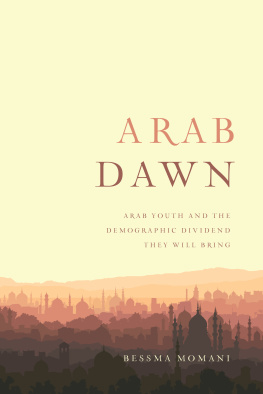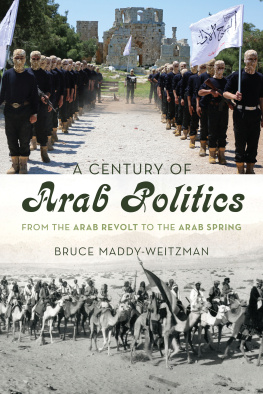ROUTLEDGE LIBRARY EDITIONS: SOCIETY OF THE MIDDLE EAST
Volume 17
PRE-SCHOOL EDUCATION IN THE ARAB WORLD
PRE-SCHOOL EDUCATION IN THE ARAB WORLD
HUDA NASHIF
First published in 1985 by Croom Helm Ltd
This edition first published in 2016
by Routledge
2 Park Square, Milton Park, Abingdon, Oxon OX14 4RN
and by Routledge
711 Third Avenue, New York, NY 10017
Routledge is an imprint of the Taylor & Francis Group, an informa business
1985 Huda Nashif
All rights reserved. No part of this book may be reprinted or reproduced or utilised in any form or by any electronic, mechanical, or other means, now known or hereafter invented, including photocopying and recording, or in any information storage or retrieval system, without permission in writing from the publishers.
Trademark notice: Product or corporate names may be trademarks or registered trademarks, and are used only for identification and explanation without intent to infringe.
British Library Cataloguing in Publication Data
A catalogue record for this book is available from the British Library
ISBN: 978-1-138-19040-5 (Set)
ISBN: 978-1-315-62817-2 (Set) (ebk)
ISBN: 978-1-138-19233-1 (Volume 17) (hbk)
Publishers Note
The publisher has gone to great lengths to ensure the quality of this reprint but points out that some imperfections in the original copies may be apparent.
Disclaimer
The publisher has made every effort to trace copyright holders and would welcome correspondence from those they have been unable to trace.
PRE-SCHOOL EDUCATION IN THE ARAB WORLD
HUDA NASHIF
1985 Huda Nashif
Croom Helm Ltd, Provident House, Burrell Row,
Beckenham, Kent BR3 1AT
Croom Helm Australia Pty Ltd, Suite 4,6th Floor,
64-76 Kippax Street, Surry Hills, NSW 2010, Australia
British Library Cataloguing in Publication Data
Nashif, Huda
Pre-school education in the Arab world.
1. Education, Preschool Kuwait
I. Title
372.21095367 LB1140.25.K8
ISBN 0-7099-0952-7
Croom Helm, 51 Washington Street,
Dover, New Hampshire 03820, USA
Library of Congress Cataloging in Publication Data
Nashif, Huda.
Pre-school education in the Arab world.
Bibliography: p.
1. Education, Pre-school - Kuwait - History. 2. Kindergartens - Kuwait - History. I. Title.
LB1140.25.K9N37 1985 372.21095367 85-22385
ISBN 0-7099-0952-7
Printed and bound in Great Britain by
Biddles Ltd, Guildford and Kings Lynn
CONTENTS
There is a growing belief among psychologists and educators that organized play of the pre-school child with a group of peers in an educational atmosphere and under the supervision of a qualified kindergarten teacher promotes the development of the young child and makes it possible for him to meet his needs and those of society with as little setbacks and relapses as possible. In other words, educators see in nurseries and kindergartens more than daycare centres where children spend part of their day in the good care of an adult while mothers are away at work. Today, pre-school institutions have defined educational goals and objectives and in the most they seek to help the child meet his developmental needs and the continuously increasing demands of modern life.
Most countries, nowadays, provide some kind of educational opportunities for children below school age. The form of such provision, its aims and objectives may differ to a greater or lesser extent from one country to another depending on its resources and the specific historical, ideological and socio-cultural forces that underlie the educational system in general.
It is, indeed, a period of reassessment of aims of pre-school education. A cross-cultural study of pre-school educational systems in different social contexts might throw light on how specific historical, social or religious factors affect the way in which early childhood education systems develop, and the way in which different cultures come to view the main goals and priorities of such education.
The Arab States of the Gulf, as indeed most of the so-called emerging countries, place special emphasis on the education of the young generation, so in time they come to hold full responsibility for the countrys development. Kuwait was foremost among the Arab Gulf countries to establish a well organized pre-school education system. This, and the fact that Kuwait is still the only Moslem Arab country where state kindergartens are open free to all Kuwaiti children between four and six, prompted the writer to study and try to answer some of the questions pertaining to early childhood education in Kuwait. Of these questions: Why is this great interest in early childhood education? What did Kuwait aim to achieve by providing kindergarten education for its children? In response to what the establishment of the kindergarten was decided upon? How did it develop, and what model or models has the kindergarten school in Kuwait followed? Is it a recurrent model in different cultural environments, or societies influenced by complex social structures have their different ways of meeting the educational needs of their children?
These are some of the questions that face those concerned with the study of patterns of pre-school education. And only a comparative study of a great number of early childhood education systems can provide the answer to these crucial issues in the education of the young child.
In this book the case of Kuwait kindergartens is presented with the hope of providing some understanding of the interplay of traditional and new ideas in early childhood education thought. To do this one needs to know something about the geographical and historical position of Kuwait as an Arab Gulf State. gives the main findings of two field studies carried out in the United Kingdom and Kuwait on aims, objectives and priorities in pre-school education. Chapter gives a comparative view of the pre-school educational systems in the two countries. Chapter , in conclusion, suggests that irrespective of differences in the cultural environment and social needs, teachers striving to achieve broad aims in education for humanity, hold similar purposes and objectives for young children.
The State of Kuwait stands at the head of the Arabian Gulf between latitudes 28 45 and 30 5 north and longitudes 46 30 and 48 30 east. It is a flat desert country of about 5,800 square miles. The overall shape of the country is rather like a triangle, with its base, about 120 miles in length, along the Arabian Gulf east. Kuwait is bounded on the south and south west by the Neutral Zone and Saudi Arabia, and on the north and north west by Iraq. The Neutral Zone, an area of about 2,200 square miles, has been administered jointly by the governments of Kuwait and Saudi Arabia since 1922. Kuwait Bay occupies nearly half of the coastline and it is a fine natural harbour. The modern capital, Kuwait City, is on the southern side of the Bay. Beneath the City and the Bay and in many parts of the desert lies oil, the source of the countrys recent wealth and increasing significance in world affairs.













